"They taught us to paint resistance and art. We are a group of facilitators, but facilitators in action, I think we have a long way to go to learn, to teach. Thank you so much for making our cultural practices always vivid in our paths"
Yeny Del Pilar Aguillón
Participant from the "Training for cultural actors process" (2020)
MEMORY
Memory is the ability of the human brain to collect stimuli in the form of images, anecdotes, and sounds experienced in the past, whether they are positive and joyful situations, or convoluted and sad. Memory contributes to the recognition, remembrance, and safeguarding of Intangible Cultural Heritage. Memory stands as a symbol of life, history, and ICH, but it is also infused with the pain, scars, and more importantly, the desire of vulnerable and marginalized communities to overcome the dangerous situations they have been exposed to.
We believe that the multiple harmful environments to which marginalized human beings are exposed to are sometimes the very reason why entire communities live in constant tension and conflict. The negative emotions that these contexts entail can be re-signified if those memories, wounds, scars, stories, and other manifestations of remembrance are addressed and processed through creativity. In this sense, we are convinced that it is possible to dignify the past through actions of peace, non-repetition, and resilience.

For this reason, Embodying Reconciliation recognizes cultural expressions not only as carriers of aesthetic and artistic value but as genuine places of enunciation from where subjects are capable of reconfiguring their meaning and representation systems. As such, we are approaching memory as integral reparation and a strategy for the exercise of human rights, which has important implications for the strengthening of social bonds in the present. We seek to transform the wounds into creative forces to build new possibilities, new pathways of existence.
This line of work suggests that education should be aimed at repairing what has been painful or has left a negative wound, to rebuild it, heal it and make it visible through actions of peace and reconciliation that, at the same time, have the potential to project a future with harmony and non-repetition of violence. Through the re-cognition and re-signification of bodily and social memories, we sharpen our commitment to intercultural coexistence in peace, under dialogical and solution-seeking strategies that hold humanity as a fundamental value and pillar.

Some methodologies that we employ to promote this type of education are: (i) The use of personal or collective artistic, bodily, visual, and sound narratives and contents; (ii) Somatic reparation techniques; (iii) Bodily, territorial, emotional and relational cartographies; and (iv) Museographic projects.
© Copyright 2016 – Corporación Embodying Reconciliation – Cuerpos para la Reconciliación
